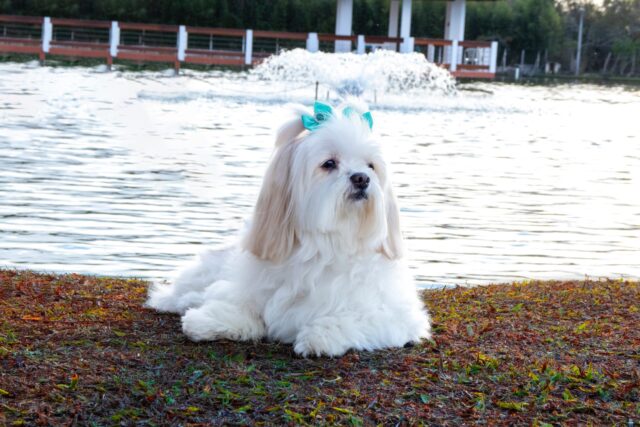Lhasa Apsos are an ancient and adorable breed known for their long, flowing coats and charming personalities. When it comes to taking care of these small yet spirited dogs, one of the essential aspects is ensuring they have regular bathroom breaks. The frequency of taking your Lhasa Apso outside to pee can vary depending on their age and individual needs. In this comprehensive guide, we’ll explore how often you should take a Lhasa Apso outside to pee, with specific guidelines for puppies, adults, and senior dogs.
Puppies: The Energetic Explorers
Puppies, including Lhasa Apsos, are bundles of energy and curiosity. They have smaller bladders and higher metabolisms than adult dogs, which means they need more frequent bathroom breaks. When it comes to taking your Lhasa Apso puppy outside to pee, the key is consistency and patience.
- Age 8-12 Weeks:
- At this stage, Lhasa Apso puppies are still developing their bladder control. You should aim to take them outside to pee every 1-2 hours.
- After eating, drinking, playing, or waking up from a nap, take your puppy out immediately. These are common triggers for needing to urinate.
- Age 12-16 Weeks:
- As your puppy gets a bit older, you can gradually increase the time between bathroom breaks to every 2-3 hours.
- Continue to take them out after meals and playtime.
- Age 16-20 Weeks:
- By this point, your Lhasa Apso should have better bladder control. You can extend the time between outdoor trips to every 3-4 hours.
- Continue to monitor your puppy’s behavior for signs that they need to pee and respond promptly.
- Age 20 Weeks and Beyond:
- As your Lhasa Apso puppy approaches adulthood, you can further increase the time between bathroom breaks to around 4-6 hours.
- Be sure to provide plenty of opportunities for exercise and play, as this can help them empty their bladder and prevent accidents.
Adults: The Well-Behaved Companions
Lhasa Apsos typically reach adulthood at around 12-18 months of age. At this stage, they have better bladder control and can hold their urine for longer periods. However, it’s essential to maintain a consistent bathroom routine to ensure they remain well-behaved and house-trained.
- Ages 1-3 Years:
- Adult Lhasa Apsos can typically go 4-6 hours between bathroom breaks.
- Schedule regular outdoor trips in the morning, after meals, and before bedtime.
- Pay attention to your dog’s behavior and cues, such as pacing, sniffing, or whining, to determine when they need to pee.
- Ages 3-7 Years:
- As your Lhasa Apso matures, they may be able to hold their urine for even longer periods, up to 6-8 hours.
- Stick to a consistent schedule, but be flexible if your dog indicates they need to go out earlier.
- Ages 7+ Years:
- Senior Lhasa Apsos may experience age-related changes, including reduced bladder control. You may need to take them out every 4-6 hours.
- Keep an eye out for signs of incontinence or difficulty holding their urine, which may require special care and veterinary attention.
It’s important to remember that individual variations exist, and some Lhasa Apsos may need more frequent bathroom breaks than others. Always be attentive to your dog’s specific needs and adapt the routine as necessary.
Senior Dogs: The Gentle Elders
As Lhasa Apsos age, their needs change, including their bathroom habits. Senior dogs often require more frequent bathroom breaks due to reduced bladder control and potential health issues. Providing them with the right care and attention is crucial during their golden years.
- Ages 7-10 Years:
- Senior Lhasa Apsos may need to go outside every 4-6 hours.
- Consider increasing the number of shorter walks to accommodate their needs.
- Ages 10+ Years:
- Dogs in their advanced years may require even more frequent bathroom breaks, every 3-4 hours.
- Watch for signs of discomfort or distress when they need to go, as seniors may struggle with mobility and coordination.
- Monitor Health:
- Regularly check your senior Lhasa Apso’s health, including for conditions like arthritis or urinary incontinence that may affect their bathroom routine.
- Consult with your veterinarian if you notice any significant changes in their bathroom habits or signs of discomfort.
Additional Factors Influencing Frequency
While age is a significant factor in determining how often you should take your Lhasa Apso outside to pee, other factors can also affect their bathroom needs:
- Diet: The type and timing of your dog’s meals can impact their need to relieve themselves. Be consistent with feeding times and avoid feeding right before bedtime.
- Water Intake: Monitor your Lhasa Apso’s water consumption. Adjust the amount and timing of water to avoid excessive drinking before bedtime.
- Exercise: Regular exercise can help your dog empty their bladder and maintain good overall health. Ensure they get appropriate daily exercise to support their bathroom routine.
- Medical Conditions: Certain medical conditions, such as urinary tract infections or diabetes, can affect your dog’s bathroom habits. If you suspect a health issue, consult your veterinarian for guidance.
- Medications: If your Lhasa Apso is on medication, it may affect their bathroom schedule. Discuss any concerns with your vet to ensure their medication is appropriately timed.
Conclusion
Taking your Lhasa Apso outside to pee at the right frequency is essential for their health, comfort, and your sanity as a pet owner. Remember that age plays a significant role in determining how often they need to go, with puppies and senior dogs requiring more frequent bathroom breaks than adults. By following the guidelines outlined in this article and paying attention to your dog’s individual needs and behavior, you can establish a consistent routine that keeps your Lhasa Apso happy and well-maintained throughout their life.

 Toledo, United States.
Toledo, United States.